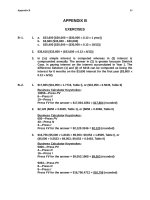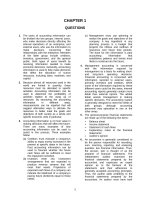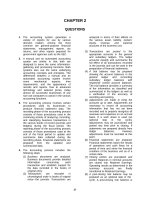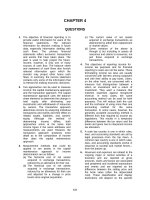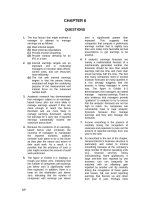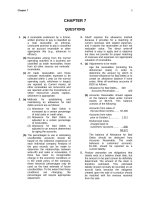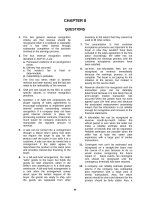Solutions manual intermediate accounting 18e by stice and stice ch08
Bạn đang xem bản rút gọn của tài liệu. Xem và tải ngay bản đầy đủ của tài liệu tại đây (288.57 KB, 52 trang )
To download more slides, ebook, solutions and test bank, visit
CHAPTER 8
QUESTIONS
separated from other inventory to the extent that they cannot be used to fill other
orders.
1. The two general revenue recognition criteria are that revenue should be recognized
when it is realized or realizable and it has
been earned through substantial completion of the activities involved in the earnings
process.
7. The presumption is that customer acceptance provisions are important to the buyer
or else they wouldn’t have been included in
the sales agreement in the first place. Accordingly, the seller has not completed the
earnings process until the customer acceptance provisions have been satisfied.
2. The four revenue recognition criteria identified in SOP 97−2 are:
a. Persuasive evidence of an arrangement
exists.
b. Delivery has occurred.
c. The vendor's fee is fixed or determinable.
d. Collectibility is probable.
The first two items relate to whether revenue has been earned, and the last two relate to the realizability of the revenue.
8. Up-front, nonrefundable fees are not recognized as revenue immediately because
the earnings process is not complete. The
buyer is not paying for the initiation of the
service, but instead is paying for the service itself.
9. An element of a multiple-element arrangement is considered to be a unit of accounting if that element has standalone value,
meaning that it can be sold separately (by
anyone, not necessarily the seller) or the
customer can resell it.
3. SAB 101 was issued by the SEC to curtail
specific abuses in revenue recognition
practices.
4. Question 1 of SAB 101 emphasizes the
proper signing of sales agreements to encourage companies to implement good internal controls surrounding revenue recognition. If a company does not have good
internal controls in place for processing
customer contracts, it becomes much easier for company executives to manipulate
the reported amount of revenue.
10. The three different methods for determining
the separate selling price of a single element in a multiple-element transaction are
as follows:
a. Vendor-specific
objective
evidence
(VSOE), which is the price at which the
same company sells the same product
or service separately.
b. Third-party evidence (TPE), which is the
price at which other companies sell the
same product or service separately.
c. Best estimate using other data such as
cost and profit margin data.
5. A sale can be turned into a consignment
through a liberal return policy that does not
require the buyer to pay for the product until the buyer in turn sells it to a customer. A
sale can also be turned into a consignment
if the seller agrees to repurchase the product at the same price and provides interestfree financing to the buyer.
11. The three basic steps in recognizing revenue under the contract approach are as follows:
a. Identify the performance obligations accepted by the seller.
b. Allocate transaction prices based on
relative separate selling prices of any
distinct elements of a multiple-element
arrangement.
c. Recognize revenue as the performance
obligations are satisfied.
6. In a bill-and-hold arrangement, the seller
“sells” goods to the buyer but holds the
goods for later shipment, either in the seller’s own warehouse or in a third-party
warehouse. A bill-and-hold arrangement is
a sale when the arrangement comes about
upon the written request of the buyer, the
goods are ready to ship, and the goods are
249
To download more slides, ebook, solutions and test bank, visit
250
12. A company would prefer gross revenue
reporting over net revenue reporting because the larger total revenue number increases the apparent size of the company’s
economic activity. If investors use a priceto-sales relationship in valuing the company, gross revenue reporting can lead to a
higher stock price.
13. If percentage-of-completion accounting is
to be used by construction contractors, the
following elements should be present in the
transaction.
a. Dependable estimates can be made of
the extent of progress toward completion, contract revenues, and contract
costs.
b. The contract should clearly specify the
enforceable rights regarding goods or
services to be provided and received
by the parties, the consideration to be
exchanged, and the manner and terms
of settlement.
c. The buyer can be expected to satisfy
obligations under the contract.
d. The contractor can be expected to perform the contractual obligation.
Because most contractors with significant
contract obligations have the experience to
make the necessary estimates, it is recommended that they use percentage-ofcompletion accounting rather than the
completed-contract method.
14. The cost-to-cost method of measuring the
percentage of completion is an input method and is computed by relating the costs
incurred to date to the total estimated
costs. The efforts-expended methods are
also input methods, but they are based on
the ratio of the efforts expended by labor or
machines on the contract to the total effort
expected to be expended. They include labor hours, labor dollars, machine hours, or
even material quantities. The percentage
computed is then applied to revenue and
costs to determine the amount reported for
the period.
15. Output measures of percentage of completion include units produced, contract milestones reached, and values added to the
contract. Particular examples of output
measures include miles of roadway, cubic
Chapter 8
yards of dirt removed, or architects' and
engineers' estimates of job completion.
16. The construction in progress account is
used to accumulate all costs directly chargeable to a contract, including a share of
indirect overhead costs and the recognized
gross profit earned to date if the company
is using the percentage-of-completion method. The progress billings on construction
contracts account is used to accumulate
the total progress billings made on a contract, including any billed retainer fees.
These accounts are offset against each
other on the balance sheet. If Construction
in Progress is the larger of the two accounts, both are reported in the Current
Asset section. If Progress Billings on Construction Contracts is larger, both are reported in the Current Liability section.
17. Some accountants feel that the costs reported under the percentage-of-completion
method should always be the costs incurred to date. If the method of arriving at
the percentage of completion is other than
the cost-to-cost method, the only way this
could occur would be to compute revenue
as the sum of costs incurred and the computed gross profit rather than by applying
the percentage of completion to the total
contract price.
18. Under percentage-of-completion accounting, the difference between recognized
revenue and recognized costs, or the recognized gross profit, is added to the costs
incurred in arriving at the balance reported
in the construction in progress account.
19. The major reason for a fluctuating gross
profit percentage under the percentage-ofcompletion method is the revision of estimates that is inherent in this type of contract. As costs incurred differ from those
anticipated, and as expectations of future
costs change over the contract time period,
the total gross profit to be earned on the
project also changes. When some profit
has already been recognized, these adjustments can create large changes in the
reported gross profit percentage from year
to year. These fluctuations would also increase if a measure of completion other
than cost-to-cost was used and if the minority position of the AICPA Construction
Contractor Guide Committee was followed.
To download more slides, ebook, solutions and test bank, visit
Chapter 8
20. If a loss is anticipated on a contract, the
entire loss should be recognized in the period when the loss is first anticipated. This
is true under both the completed-contract
and the percentage-of-completion methods.
Under the completed-contract method, the
amount of the expected loss is charged to a
loss account and credited to Construction
in Progress. Under the percentage-ofcompletion method, however, the amount of
the loss plus any profit recognized in prior
periods on the contract must be recognized
and reported as a loss. Under either method, the balance reported in Construction
in Progress will be the same.
21. The measures used to compute a percentage of performance in long-term service
contracts depend on the nature of the acts
of service to be performed. If the acts of
service are identical or similar in nature, an
output measure derived by relating the
number of acts performed to the total number of acts to be performed over the contract life is recommended. If the acts are
defined, but are not identical, the sales
value of the acts performed to date related
to the total contract sales value is used.
22. When a service company is organized and
its activities grow rapidly in the early years
of its life, the deferral of all revenue over
the service life fails to recognize any profit
on the sale of the contracts. Because the
sale is the critical event in many service
companies, failure to recognize profit in the
early years of a company results in both direct and indirect costs being charged
against very little revenue. Thus, in a newly
formed company, large losses will often be
shown even if the company may be profitable over time. The deferred revenue recognition method may not do an acceptable
job of predicting the pattern of future cash
flows.
23. The three methods of revenue recognition
that await the receipt of cash are (a) installment sales, (b) cost recovery, and (c)
cash. Under the installment sales method,
a portion of each cash receipt is recognized
251
as income. Under the cost recovery method, no income is recognized until all costs
are recovered. Under the cash method, all
costs incurred are expensed immediately,
and all cash receipts are recognized as
revenue. Costs incurred are deferred and
matched against cash received under both
the installment sales and cost recovery methods. As indicated previously, under the
cash method all costs are expensed immediately.
24. The installment sales method of accounting
is preferred over the full accrual method if
cash collection is highly uncertain and if the
amount of loss due to uncollectible accounts cannot be reasonably estimated.
This can occur if the sales transaction is
unusual in nature and involves a customer
in a way that default carries little cost or
penalty.
25. Installment sales accounting requires recognition of gross profit as the cash is collected. The amount to be recognized is
based on the gross profit percentage of the
sales year. Because these percentages
can vary from year to year, it is necessary
to maintain records that identify sales and
collections by year and to maintain a record
of each year's gross profit percentage.
26. Interest on installment sales contracts
should be recognized each period as
earned. Each cash collection, therefore,
should be reduced by the interest earned
before the gross profit percentage is applied to the balance of the collection to determine the gross profit earned.
27. The cash method of recognizing revenue
would be acceptable for reporting purposes
only if the probability of recovery of product
or service costs is slight. Seldom would the
method be appropriate for product or real
estate sales because of repossession
rights held by the seller. However, in service contracts with high initial costs and
great uncertainty as to collection, the cash
method might be appropriate.
To download more slides, ebook, solutions and test bank, visit
Chapter 8
252
PRACTICE EXERCISES
PRACTICE 8–1
1.
2.
Cash..........................................................................................
Unearned Service Revenue ..............................................
1,000
Unearned Service Revenue....................................................
Service Revenue................................................................
1,000
PRACTICE 8–2
1.
2.
2.
3.
2.
3.
1,000
JOURNAL ENTRIES FOR A CONSIGNMENT
12,000
Accounts Receivable ..............................................................
Sales ...................................................................................
18,000
Cost of Goods Sold.................................................................
Inventory on Consignment ...............................................
12,000
12,000
18,000
12,000
JOURNAL ENTRIES FOR A LAYAWAY
Cash (2 × $50) ..........................................................................
Deposits Received from Customers................................
100
Cash..........................................................................................
Deposits Received from Customers .....................................
Sales ...................................................................................
300
50
Cost of Goods Sold.................................................................
Inventory ............................................................................
200
Deposits Received from Customers .....................................
Revenue from Layaway Forfeitures.................................
50
PRACTICE 8–4
1.
1,000
Inventory on Consignment.....................................................
Inventory ............................................................................
PRACTICE 8–3
1.
BASIC JOURNAL ENTRIES FOR REVENUE RECOGNITION
100
350
200
50
JOURNAL ENTRIES FOR AN UP-FRONT, NONREFUNDABLE FEE
Cash (200 × $360) ....................................................................
Unearned Initial Sign-up Fees ..........................................
72,000
Cash (200 × $50) ......................................................................
Monthly Service Revenue .................................................
10,000
Unearned Initial Sign-up Fees ($72,000/36 months) ............
Initial Sign-up Fee Revenue .............................................
2,000
72,000
10,000
2,000
To download more slides, ebook, solutions and test bank, visit
Chapter 8
PRACTICE 8–5
253
REVENUE IN A MULTIPLE-ELEMENT ARRANGEMENT UNDER
SUBTOPIC 605-25
Equipment delivery = $280,645 = $300,000 × [$290,000/($290,000 + $20,000)]
Installation = $19,355 = $300,000 × [$20,000/($290,000 + $20,000)]
The amount of revenue that should be recognized by Seller Company when the
equipment is delivered but before it is installed is $280,645.
PRACTICE 8–6
1.
2.
Accounts Receivable ($400,000 × 0.03) ................................
Commission Revenue .......................................................
12,000
Cash..........................................................................................
Accounts Receivable ........................................................
12,000
Cash..........................................................................................
Sales ...................................................................................
400,000
Cost of Goods Sold.................................................................
Inventory ............................................................................
280,000
Commission Expense.............................................................
Cash....................................................................................
12,000
PRACTICE 8–7
1.
REPORTING REVENUE GROSS AND NET
400,000
280,000
12,000
Percentage of completion: [$100,000/($100,000 + $450,000)] = 18.182%
$160,002
0
$160,002
Percentage of completion: [($100,000 + $150,000)/($100,000 + $150,000 +
$280,000)] = 47.170%
Cumulative revenue to be recognized:
$880,000 × 0.47170........................................................
Revenue recognized in previous years..........................
Revenue to be recognized in Year 2...............................
3.
12,000
COST-TO-COST METHOD
Cumulative revenue to be recognized:
$880,000 × 0.18182........................................................
Revenue recognized in previous years..........................
Revenue to be recognized in Year 1...............................
2.
12,000
$415,096
160,002
$255,094
Percentage of completion: 100.000%
Cumulative revenue to be recognized:
$880,000 × 1.00000........................................................
Revenue recognized in previous years..........................
Revenue to be recognized in Year 3...............................
$880,000
415,096
$464,904
To download more slides, ebook, solutions and test bank, visit
Chapter 8
254
PRACTICE 8–8
1.
EFFORTS-EXPENDED METHOD
Percentage of completion: [150/(150 + 850)] = 15.000%
Cumulative revenue to be recognized:
$880,000 × 0.15000........................................................
Revenue recognized in previous years..........................
Revenue to be recognized in Year 1...............................
2.
Percentage of completion: [(150 + 300)/(150 + 300 + 520)] = 46.392%
Cumulative revenue to be recognized:
$880,000 × 0.46392........................................................
Revenue recognized in previous years..........................
Revenue to be recognized in Year 2...............................
3.
PRACTICE 8–9
Percentage of completion: [3,000/(3,000 + 15,200)] = 16.484%
$ 145,059
0
$ 145,059
Percentage of completion: [(3,000 + 7,500)/(3,000 + 7,500 + 8,200)] = 56.150%
Cumulative revenue to be recognized:
$880,000 × 0.56150........................................................
Revenue recognized in previous years..........................
Revenue to be recognized in Year 2...............................
3.
$880,000
408,250
$471,750
PERCENTAGE OF COMPLETION BASED ON OUTPUT MEASURES
Cumulative revenue to be recognized:
$880,000 × 0.16484........................................................
Revenue recognized in previous years..........................
Revenue to be recognized in Year 1...............................
2.
$408,250
132,000
$276,250
Percentage of completion: 100.000%
Cumulative revenue to be recognized:
$880,000 × 1.00000........................................................
Revenue recognized in previous years..........................
Revenue to be recognized in Year 3...............................
1.
$132,000
0
$132,000
$ 494,120
145,059
$ 349,061
Percentage of completion: 100.000%
Cumulative revenue to be recognized:
$880,000 × 1.00000........................................................
Revenue recognized in previous years..........................
Revenue to be recognized in Year 3...............................
$ 880,000
494,120
$ 385,880
To download more slides, ebook, solutions and test bank, visit
Chapter 8
255
PRACTICE 8–10 BASIC CONSTRUCTION JOURNAL ENTRIES
1.
2.
3.
Construction in Progress .......................................................
Materials, Cash, etc. ..........................................................
100,000
Accounts Receivable ..............................................................
Progress Billings ...............................................................
200,000
Cash..........................................................................................
Accounts Receivable ........................................................
180,000
Construction in Progress .......................................................
Materials, Cash, etc. ..........................................................
150,000
Accounts Receivable ..............................................................
Progress Billings ...............................................................
200,000
Cash..........................................................................................
Accounts Receivable ........................................................
170,000
Construction in Progress .......................................................
Materials, Cash, etc. ..........................................................
250,000
Accounts Receivable ..............................................................
Progress Billings ...............................................................
480,000
Cash..........................................................................................
Accounts Receivable ........................................................
530,000
100,000
200,000
180,000
150,000
200,000
170,000
250,000
480,000
530,000
PRACTICE 8–11 COMPLETED-CONTRACT JOURNAL ENTRIES
Progress Billings .............................................................................
Revenue on Construction Contracts ....................................
880,000
Cost of Construction Contracts .....................................................
Construction in Progress .......................................................
500,000
880,000
500,000
PRACTICE 8–12 PERCENTAGE-OF-COMPLETION JOURNAL ENTRIES
1.
2.
3.
Cost of Construction Contracts.............................................
Construction in Progress .......................................................
Revenue on Construction Contracts...............................
100,000
60,002
Cost of Construction Contracts.............................................
Construction in Progress .......................................................
Revenue on Construction Contracts...............................
150,000
105,094
Cost of Construction Contracts.............................................
Construction in Progress .......................................................
Revenue on Construction Contracts...............................
250,000
214,904
160,002
255,094
464,904
To download more slides, ebook, solutions and test bank, visit
Chapter 8
256
PRACTICE 8–13 CONSTRUCTION CONTRACTS: BALANCE SHEET REPORTING
1.
Accounts receivable is reported as a current asset. The balance at the end of
each year is computed as follows:
Year 1: $200,000 – $180,000 = $20,000
Year 2: $20,000 + $200,000 – $170,000 = $50,000
Year 3: $50,000 + $480,000 – $530,000 = $0
2. and 3.
For balance sheet reporting purposes, Progress Billings and Construction in
Progress are netted against one another. If the cumulative amount of Progress
Billings is larger, the net amount is reported as a current liability. If the cumulative amount of Construction in Progress is larger, the net amount is reported as
a current asset.
Year 1
Progress billings: $200,000
Construction in progress: $100,000 (cost) + $60,002 (profit) = $160,002
Net current liability of $39,998 ($200,000 – $160,002)
Year 2
Progress billings: $200,000 beginning balance + $200,000 = $400,000
Construction in progress: $160,002 (beginning balance) + $150,000 (cost) +
$105,094 (profit) = $415,096
Net current asset of $15,096 ($400,000 – $415,096)
Year 3
Progress billings: $400,000 beginning balance + $480,000 = $880,000
Construction in progress: $415,096 (beginning balance) + $250,000 (cost) +
$214,904 (profit) = $880,000
No net amount is reported because both Construction in Progress and Progress Billings are equal to $880,000. It would be appropriate to report the two
amounts, netting to zero, in either the Current Asset or Current Liability section
of the balance sheet.
To download more slides, ebook, solutions and test bank, visit
Chapter 8
257
PRACTICE 8–14 MULTIPLE YEARS OF REVENUES AND COSTS: COST-TO-COST
METHOD
1.
Percentage of completion: [$280,000/($280,000 + $760,000)] = 26.9231%
Cumulative revenue to be recognized:
$1,800,000 × 0.269231 ..................................................
Revenue recognized in previous years..........................
Revenue to be recognized in Year 1...............................
$ 484,616
0
$ 484,616
Cumulative cost to be recognized:
($280,000 + $760,000) × 0.269231 ................................
Cost recognized in previous years.................................
Cost to be recognized in Year 1......................................
$ 280,000
0
$ 280,000
Cost of Construction Contracts.............................................
Construction in Progress .......................................................
Revenue on Construction Contracts...............................
2.
484,616
Percentage of completion: [($280,000 + $390,000)/($280,000 + $390,000 +
$380,000)] = 63.8095%
Cumulative revenue to be recognized:
$1,800,000 × 0.638095 ..................................................
Revenue recognized in previous years..........................
Revenue to be recognized in Year 2...............................
$1,148,571
484,616
$ 663,955
Cumulative cost to be recognized:
($280,000 + $390,000 + $380,000) × 0.638095.............
Cost recognized in previous years.................................
Cost to be recognized in Year 2......................................
$ 670,000
280,000
$ 390,000
Cost of Construction Contracts.............................................
Construction in Progress .......................................................
Revenue on Construction Contracts...............................
3.
280,000
204,616
390,000
273,955
663,955
Percentage of completion: 100.000%
Cumulative revenue to be recognized:
$1,800,000 × 1.000000 ..................................................
Revenue recognized in previous years..........................
Revenue to be recognized in Year 3...............................
$1,800,000
1,148,571
$ 651,429
Cumulative cost to be recognized:
($280,000 + $390,000 + $370,000) × 1.000000.............
Cost recognized in previous years.................................
Cost to be recognized in Year 3......................................
$1,040,000
670,000
$ 370,000
Cost of Construction Contracts.............................................
Construction in Progress .......................................................
Revenue on Construction Contracts...............................
370,000
281,429
651,429
To download more slides, ebook, solutions and test bank, visit
Chapter 8
258
PRACTICE 8–15 MULTIPLE YEARS OF REVENUES AND COSTS: OUTPUT MEASURE
1.
Percentage of completion: [9,800/(9,800 + 20,300)] = 32.5581%
Cumulative revenue to be recognized:
$1,800,000 × 0.325581 ..................................................
Revenue recognized in previous years..........................
Revenue to be recognized in Year 1...............................
$586,046
0
$586,046
Cumulative cost to be recognized:
($280,000 + $760,000) × 0.325581 ................................
Cost recognized in previous years.................................
Cost to be recognized in Year 1......................................
$338,604
0
$338,604
Cost of Construction Contracts.............................................
Construction in Progress .......................................................
Revenue on Construction Contracts...............................
2.
586,046
Percentage of completion: [(9,800 + 10,200)/(9,800 + 10,200 + 10,000)] =
66.6667%
Cumulative revenue to be recognized:
$1,800,000 × 0.666667 ..................................................
Revenue recognized in previous years..........................
Revenue to be recognized in Year 2...............................
$1,200,000
586,046
$ 613,954
Cumulative cost to be recognized:
($280,000 + $390,000 + $380,000) × 0.666667.............
Cost recognized in previous years.................................
Cost to be recognized in Year 2......................................
$ 700,000
338,604
$ 361,396
Cost of Construction Contracts.............................................
Construction in Progress .......................................................
Revenue on Construction Contracts...............................
3.
338,604
247,442
361,396
252,558
613,954
Percentage of completion: 100.000%
Cumulative revenue to be recognized:
$1,800,000 × 1.000000 ..................................................
Revenue recognized in previous years..........................
Revenue to be recognized in Year 3...............................
$1,800,000
1,200,000
$ 600,000
Cumulative cost to be recognized:
($280,000 + $390,000 + $370,000) × 1.000000.............
Cost recognized in previous years.................................
Cost to be recognized in Year 3......................................
$ 1,040,000
700,000
$ 340,000
Cost of Construction Contracts.............................................
Construction in Progress .......................................................
Revenue on Construction Contracts...............................
340,000
260,000
600,000
To download more slides, ebook, solutions and test bank, visit
Chapter 8
259
PRACTICE 8–16 MULTIPLE YEARS OF REVENUES AND COSTS: ANTICIPATED
LOSS
1.
Percentage of completion: [$200,000/($200,000 + $1,150,000)] = 14.8148%
Cumulative revenue to be recognized:
$1,450,000 × 0.148148 ..................................................
Revenue recognized in previous years.........................
Revenue to be recognized in Year 1..............................
$214,815
0
$214,815
With the cost-to-cost method, the percentage of cost and the actual cost are the
same, unless the contract has an anticipated loss as illustrated in Year 2.
Cost of Construction Contracts.............................................
Construction in Progress .......................................................
Revenue on Construction Contracts...............................
2.
214,815
Percentage of completion: [($200,000 + $350,000)/($200,000 + $350,000 +
$1,020,000)] = 35.0319%
However, the contract now has a total anticipated loss of $120,000 [$1,450,000 –
($200,000 + $350,000 + $1,020,000)].
Cumulative revenue to be recognized:
$1,450,000 × 0.350319 ..................................................
Revenue recognized in previous years.........................
Revenue to be recognized in Year 2..............................
$507,963
214,815
$293,148
Cumulative cost to be recognized:
($507,963 + $120,000 anticipated loss).......................
Cost recognized in previous years................................
Cost to be recognized in Year 2.....................................
$627,963
200,000
$427,963
Cost of Construction Contracts.............................................
Construction in Progress .................................................
Revenue on Construction Contracts...............................
3.
200,000
14,815
427,963
134,815
293,148
Percentage of completion: 100.000%
Cumulative revenue to be recognized:
$1,450,000 × 1.000000 ..................................................
Revenue recognized in previous years.........................
Revenue to be recognized in Year 3..............................
$1,450,000
507,963
$ 942,037
Cumulative cost to be recognized:
($200,000 + $350,000 + $915,000) × 1.000000.............
Cost recognized in previous years................................
Cost to be recognized in Year 3.....................................
$1,465,000
627,963
$ 837,037
Cost of Construction Contracts.............................................
Construction in Progress .......................................................
Revenue on Construction Contracts...............................
837,037
105,000
942,037
To download more slides, ebook, solutions and test bank, visit
Chapter 8
260
PRACTICE 8–17 JOURNAL ENTRIES FOR THE PROPORTIONAL PERFORMANCE
METHOD
1.
2.
3.
Cash (1,900 × $600) ................................................................. 1,140,000
Unearned Season Ticket Revenue...................................
Deferred Initial Season Ticket Costs.....................................
Cash....................................................................................
180,000
Unearned Season Ticket Revenue ........................................
Season Ticket Revenue [$1,140,000 × (21/55)] ...............
435,273
Season Ticket Game Costs ....................................................
Cash (1,900 × $3 × 21) .......................................................
119,700
Initial Season Ticket Costs [$180,000 × (21/55)]...................
Deferred Initial Season Ticket Costs ...............................
68,727
1,140,000
180,000
435,273
119,700
68,727
PRACTICE 8–18 INSTALLMENT SALES: BASIC JOURNAL ENTRIES
Installment Accounts Receivable ..................................................
Installment Sales.....................................................................
350,000
Cost of Installment Sales ($350,000 × 0.80) ..................................
Inventory ..................................................................................
280,000
Cash ($350,000 × 0.40) ....................................................................
Installment Accounts Receivable ..........................................
140,000
Installment Sales .............................................................................
Cost of Installment Sales .......................................................
Deferred Gross Profit..............................................................
350,000
Deferred Gross Profit ......................................................................
Realized Gross Profit on Installment Sales..........................
28,000
350,000
280,000
140,000
280,000
70,000
28,000
($140,000 collected × 20% profit margin = $28,000)
or ($70,000 deferred gross profit × 40% cash collected = $28,000)
PRACTICE 8–19 INSTALLMENT SALES: FINANCIAL STATEMENT REPORTING
Installment sales receivable: $350,000 – $140,000 = $210,000
Deferred gross profit: $70,000 – $28,000 = $42,000
Balance sheet reporting:
Installment sales receivable...........................................
Less deferred gross profit..............................................
Net installment sales receivable....................................
$210,000
(42,000)
$168,000
To download more slides, ebook, solutions and test bank, visit
Chapter 8
261
PRACTICE 8–20 INSTALLMENT SALES: INTEREST ON RECEIVABLES
1.
2.
Installment Accounts Receivable ..........................................
Installment Sales ...............................................................
200,000
Cost of Goods Sold.................................................................
Inventory ............................................................................
110,000
Cash..........................................................................................
Installment Accounts Receivable ....................................
Interest Revenue ($200,000 × 0.21) ..................................
90,000
Installment Sales.....................................................................
Cost of Goods Sold ...........................................................
Deferred Gross Profit ........................................................
200,000
Deferred Gross Profit..............................................................
Realized Gross Profit ........................................................
($48,000/$200,000) × $90,000
21,600
Installment Accounts Receivable ..........................................
Installment Sales ...............................................................
220,000
Cost of Goods Sold.................................................................
Inventory ............................................................................
130,000
Cash..........................................................................................
Installment Accounts Receivable ....................................
Interest Revenue................................................................
200,000
200,000
110,000
48,000
42,000
110,000
90,000
21,600
220,000
130,000
121,880
78,120
From Year 1: ($200,000 – $48,000) × 0.21 = $31,920
From Year 2: $220,000 × 0.21 = $46,200
$31,920 + $46,200 = $78,120
Installment Sales.....................................................................
Cost of Goods Sold ...........................................................
Deferred Gross Profit ........................................................
220,000
Deferred Gross Profit..............................................................
Realized Gross Profit ........................................................
52,645
130,000
90,000
From Year 1: Principal cash collections = $100,000 – $31,920 = $68,080
From Year 2: Principal cash collections = $100,000 – $46,200 = $53,800
From Year 1: Realized gross profit = ($68,080/$200,000) × $90,000 = $30,636
From Year 2: Realized gross profit = ($53,800/$220,000) × $90,000 = $22,009
$30,636 + $22,009 = $52,645
52,645
To download more slides, ebook, solutions and test bank, visit
Chapter 8
262
PRACTICE 8–21 COST RECOVERY METHOD: BASIC JOURNAL ENTRIES
Year 1
Cash
Gross Profit
Collected Recognized
Year 1
$140,000
Sales = $350,000
$
0
Gross Profit % = 20%
COGS = $280,000
Year 2
Sales = $270,000
Gross Profit % = 25%
COGS = $202,500
⎯
Year 3
Sales = $210,000
Gross Profit % = 30%
COGS = $147,000
⎯
1.
2.
⎯
⎯
Year 2
Cash
Gross Profit
Collected Recognized
$175,000
$35,000
108,000
Year 3
Cash
Gross Profit
Collected Recognized
$
0
$
0
135,000
0
⎯
⎯
40,500
84,000
0
Installment Accounts Receivable—Year 1 ...........................
Installment Sales ...............................................................
350,000
Cost of Goods Sold.................................................................
Inventory ............................................................................
280,000
Cash..........................................................................................
Installment Accounts Receivable—Year 1......................
140,000
Installment Sales.....................................................................
Cost of Goods Sold ...........................................................
Deferred Gross Profit—Year 1 .........................................
350,000
Installment Accounts Receivable—Year 2 ...........................
Installment Sales ...............................................................
270,000
Cost of Goods Sold.................................................................
Inventory ............................................................................
202,500
Cash..........................................................................................
Installment Accounts Receivable—Year 2......................
108,000
Installment Sales.....................................................................
Cost of Goods Sold ...........................................................
Deferred Gross Profit—Year 2 .........................................
270,000
Cash..........................................................................................
Installment Accounts Receivable—Year 1......................
175,000
Deferred Gross Profit—Year 1 ...............................................
Realized Gross Profit ........................................................
35,000
350,000
280,000
140,000
280,000
70,000
270,000
202,500
108,000
202,500
67,500
175,000
35,000
To download more slides, ebook, solutions and test bank, visit
Chapter 8
263
PRACTICE 8–21 (Concluded)
3.
Installment Accounts Receivable—Year 3 ...........................
Installment Sales ...............................................................
210,000
Cost of Goods Sold.................................................................
Inventory ............................................................................
147,000
Cash..........................................................................................
Installment Accounts Receivable—Year 3......................
84,000
Installment Sales.....................................................................
Cost of Goods Sold ...........................................................
Deferred Gross Profit—Year 3 .........................................
210,000
Cash..........................................................................................
Installment Accounts Receivable—Year 2......................
135,000
Deferred Gross Profit—Year 2 ...............................................
Realized Gross Profit ........................................................
40,500
210,000
147,000
84,000
147,000
63,000
135,000
40,500
To download more slides, ebook, solutions and test bank, visit
Chapter 8
264
EXERCISES
8–22.
2014 Inventory on Consignment......................................
Retained Earnings (0.30 × $45,000) ........................
Accounts Receivable ...........................................
To correct error made in 2013.
45,000
13,500
Receivable from Consignee ($12,000 × 1.3)...........
Consignment Sales..............................................
15,600
Cost of Consignment Goods Sold..........................
Inventory on Consignment..................................
12,000
Inventory ...................................................................
Inventory on Consignment..................................
33,000
Commission Expense ($15,600 × 0.15)...................
Cash...........................................................................
Receivable from Consignee ................................
2,340
13,260
58,500
15,600
12,000
33,000
15,600
8–23.
a.
No entry. Shady has received no order from Point, so no sale should be
recognized no matter how much Shady segregates the inventory.
b.
No entry. As explained in Question 1 of SAB 101, no sale should be
recognized if the sales agreement is unsigned and yet normal procedure includes the formal signing of the sales agreement by both the
buyer and the seller. In addition, a bill-and-hold arrangement should
not be recognized as a sale in the absence of a written request from the
buyer.
c.
This scenario describes a case in which a bill-and-hold arrangement
can be recognized as a sale. The appropriate journal entry is as follows:
d.
Accounts Receivable ...................................................
Sales ..........................................................................
890,000
Cost of Goods Sold ......................................................
Inventory ...................................................................
530,000
890,000
530,000
No entry. No sale should be recognized until all substantive customer
acceptance provisions have been satisfied.
To download more slides, ebook, solutions and test bank, visit
Chapter 8
265
8–24.
Cash (300 × $2,000)............................................................
Unearned Lifetime Membership Fees ........................
Unearned Wellness Evaluation Fees .........................
600,000
488,372
111,628
Lifetime membership fees: [$1,750/($1,750 + $400)] × $600,000 = $488,372
Wellness evaluation fees: [$400/($1,750 + $400)] × $600,000 = $111,628
Unearned Wellness Evaluation Fees ...............................
Wellness Evaluation Fees ...........................................
111,628
Cost of Wellness Evaluation Fees ...................................
Cash (300 × $70) ...........................................................
21,000
Unearned Lifetime Membership Fees..............................
Lifetime Membership Fees ($488,372/5 years)..........
97,674
Cost of Lifetime Membership Fees ..................................
Cash (300 × $250).........................................................
75,000
111,628
21,000
97,674
75,000
8–25.
2013
Construction in Progress ................
Materials, Labor, Cash, etc. .......
To record costs incurred
on contract.
1,930,000
Accounts Receivable ......................
Progress Billings on
Construction Contracts ............
To record contract billings.
2,100,000
Cash...................................................
Accounts Receivable..................
To record collections on
contract.
1,800,000
2,290,000
1,930,000
2,290,000
2,900,000
2,100,000
2,900,000
3,200,000
1,800,000
Progress Billings on
Construction Contracts..................
Revenue from Long-Term
Construction Contracts ............
To record recognition
of revenue.
Cost of Long-Term
Construction Contracts ................
Construction in Progress ..........
To record recognition
of expenses.
2014
3,200,000
5,000,000
no entry
no entry
5,000,000
4,220,000
4,220,000
To download more slides, ebook, solutions and test bank, visit
Chapter 8
266
8–26.
1.
Total gross profit recognized on contract:
2012..........................................
$ 75,000
2013..........................................
140,000
2014..........................................
(20,000)
$195,000
Total cost incurred on contract:
Contract price .............................................
Less gross profit recognized ....................
Total cost incurred ............................................
Total cost incurred in 2013:
Total cost incurred—contract ...................
Less cost incurred:
2012 .........................................................
2014 .........................................................
Total cost incurred—2013 ................................
2.
$2,000,000
195,000
$1,805,000
$1,805,000
$360,000
820,000
1,180,000
$ 625,000
Total cost incurred and gross profit recognized to the end of 2013:
2012.....................................
2013.....................................
Cost
Incurred
$360,000
625,000
$985,000
Gross Profit
Recognized
Total
$ 75,000
$ 435,000
140,000
765,000
$ 215,000
$1,200,000
Percentage of job completed at the end of 2013:
Total cost incurred and gross profit recognized
to end of 2013 ....................................................................
Total contract price ..............................................................
Percentage of project completed by the end of 2013 .......
$1,200,000
2,000,000
60%
3.
Total gross profit recognized to end of 2013............................
Percentage of project completed by end of 2013 ....................
Total estimated gross profit on project as of end of 2013 ...
$ 215,000
÷
60%
$ 358,333
4.
Total cost incurred to end of 2013.............................................
Percentage of project completed by end of 2013 ....................
Total estimated cost on contract as of end of 2013..............
Less cost incurred to date..........................................................
Estimated cost to complete contract as of end of 2013 .......
$ 985,000
÷
60%
$1,641,667
985,000
$ 656,667
To download more slides, ebook, solutions and test bank, visit
Chapter 8
267
8–27.
1.
2.
3.
Actual cost incurred to date.........
Estimated cost to complete
contract........................................
Total estimated cost......................
2012
$1,900,000
2013
$5,500,000
2014
$7,170,000
5,150,000
$7,050,000
1,600,000
$7,100,000
0
$7,170,000
Percentage of completion
to date [(1)/(3)].............................
26.95%
77.46%
100%
To Date
2012—(26.95% completed):
Recognized revenue
($9,000,000 × 26.95%).............
Cost (actual cost) ..........................
Gross profit .................................
2013—(77.46% completed):
Recognized revenue
($8,600,000 × 77.46%).............
Cost (actual cost) ..........................
Gross profit .................................
2014—(100% completed):
Recognized revenue .....................
Cost.................................................
Gross profit .................................
Recognized Recognized
in
in
Prior Years Current Year
$2,425,500
1,900,000
$ 525,500
$2,425,500
1,900,000
$ 525,500
$6,661,560
5,500,000
$1,161,560
$2,425,500
1,900,000
$ 525,500
$ 4,236,060
3,600,000
$ 636,060
$8,600,000
7,170,000
$1,430,000
$6,661,560
5,500,000
$1,161,560
$ 1,938,440
1,670,000
$ 268,440
8–28.
1.
2.
3.
4.
5.
6.
$20,000 ($220,000 – $200,000)
$260,000 ($250,000 + $10,000)
$370,000 [$850,000 – ($220,000 + $260,000)]
$380,000 ($370,000 + $10,000)
$830,000 ($200,000 + $250,000 + $380,000)
$86,095
2013: 450/640 = 0.7031; 0.7031 × $850,000 = $ 597,635 Cumulative revenue
less cumulative costs
(450,000)
Cumulative gross profit
$ 147,635
2012: 200/650 = 0.3077; 0.3077 × $200,000 =
(61,540) Gross profit
recognized—2012
$ 86,095 Gross profit
recognized—2013
To download more slides, ebook, solutions and test bank, visit
Chapter 8
268
8–29.
1.
Percentage-of-completion method:
2013 Contract price .............................................
Less estimated cost:
Cost to date ...........................................
$60,000
Estimated cost to complete project .....
59,000
Estimated gross profit...........................
Percentage completed ($60,000/$119,000)
50.42%
Estimated gross profit—2013
($81,000 × 50.42%)..................................
Balance sheet:
Current assets:
Accounts receivable
($80,000 billed – $55,000 received)
Construction in progress.................. $100,840*
Less: Progress billings on
construction contracts ...................
80,000
$200,000
119,000
$ 81,000
$ 40,840
$ 25,000
20,840
*$60,000 cost to date + $40,840 income = $100,840
Income statement:
Revenue ($200,000 × 0.5042).................
Cost of construction..............................
Gross profit.............................................
2.
Completed-contract method:
Balance sheet:
Current assets:
Accounts receivable ...................................
Current liabilities:
Progress billings on construction
contracts ................................................... $80,000
Less: Construction in progress ................
60,000
Income statement:
Nothing reported. No contract was completed.
$100,840
60,000
$ 40,840
$25,000
20,000
To download more slides, ebook, solutions and test bank, visit
Chapter 8
8–30.
269
2012 Construction in Progress ...................................
Materials, Labor, Cash, etc. ...........................
7,600,000
Accounts Receivable ..........................................
Progress Billings on Construction
Contracts.......................................................
9,500,000
Cash......................................................................
Accounts Receivable ......................................
9,000,000
7,600,000
9,500,000
9,000,000
Cost of Long-Term Construction Contracts..... 7,800,000*
Construction in Progress ................................... 1,200,000†
Revenue from Long-Term Construction
Contracts.......................................................
9,000,000
*0.30 × $26,000,000 = $7,800,000
†
0.30 × $4,000,000 ($30,000,000 – $26,000,000) = $1,200,000
2013 Construction in Progress ...................................
Materials, Labor, Cash, etc. ...........................
9,700,000
9,700,000
Accounts Receivable .......................................... 11,500,000
Progress Billings on Construction
Contracts.......................................................
11,500,000
Cash...................................................................... 10,300,000
Accounts Receivable ......................................
10,300,000
Cost of Long-Term Construction Contracts..... 13,160,000*
Construction in Progress ................................... 1,840,000†
Revenue from Long-Term Construction
Contracts.......................................................
15,000,000
*0.80 × $26,200,000 = $20,960,000;
$20,960,000 – $7,800,000 = $13,160,000
†
0.80 × ($30,000,000 – $26,200,000) = $3,040,000;
$3,040,000 – $1,200,000 = $1,840,000
2014 Construction in Progress ...................................
Materials, Labor, Cash, etc. ...........................
8,800,000
Accounts Receivable ..........................................
Progress Billings on Construction
Contracts.......................................................
9,000,000
8,800,000
9,000,000
Cash...................................................................... 10,700,000
Accounts Receivable ......................................
10,700,000
Cost of Long-Term Construction Contracts..... 5,140,000*
Construction in Progress ...................................
860,000
Revenue from Long-Term Construction
Contracts.......................................................
6,000,000
*$26,100,000 – ($13,160,000 + $7,800,000) = $5,140,000
Progress Billings on Construction Contracts .. 30,000,000
Construction in Progress ...............................
30,000,000
To download more slides, ebook, solutions and test bank, visit
Chapter 8
270
8–31.
2012 Construction in Progress ...................................
Materials, Labor, Cash, etc. ...........................
7,200,000
Accounts Receivable ..........................................
Progress Billings on Construction
Contracts.......................................................
7,200,000
Cash......................................................................
Accounts Receivable ......................................
6,500,000
2013 Construction in Progress ...................................
Materials, Labor, Cash, etc. ...........................
6,700,000
Accounts Receivable ..........................................
Progress Billings on Construction
Contracts.......................................................
6,500,000
Cash......................................................................
Accounts Receivable ......................................
6,400,000
Anticipated Loss on Long-Term Construction
Contracts ............................................................
Construction in Progress ...............................
$700,000 of loss recognized in 2013.
*Contract price.....................................
Costs incurred 2012–2013..............
Estimated cost to complete ...........
Estimated loss.................................
7,200,000
7,200,000
6,500,000
6,700,000
6,500,000
6,400,000
700,000*
700,000
$21,000,000
$13,900,000
7,800,000
21,700,000
$ (700,000)
2014 Construction in Progress ...................................
Materials, Labor, Cash, etc. ...........................
7,900,000
Accounts Receivable ..........................................
Progress Billings on Construction
Contracts.......................................................
7,300,000
Cash......................................................................
Accounts Receivable ......................................
8,100,000
7,900,000
7,300,000
8,100,000
Progress Billings on Construction Contracts .. 21,000,000
Revenue from Long-Term
Construction Contracts ...............................
21,000,000
Cost of Long-Term Construction Contracts..... 21,100,000
Construction in Progress ...............................
21,100,000
To download more slides, ebook, solutions and test bank, visit
Chapter 8
271
8–32.
Basic contract ................
Change Order 1 ..............
Change Order 2 ..............
Change Order 3 ..............
Change Order 4 ..............
Costs—
2013
$8,000,000
50,000
—
300,000
125,000
$8,475,000
Estimated Cost Estimated
Contract
to Complete
Total Cost
Price
$ 28,000,000
$36,000,000 $42,000,000
50,000
100,000
125,000
50,000
50,000
—
300,000
600,000
600,000
—
125,000
100,000
$ 28,400,000
$36,875,000 $42,825,000
Percentage completed:
$8,475,000/$36,875,000 = 22.98%
Revenues: 22.98% × $42,825,000..................................
Costs actually incurred .................................................
Gross profit to be recognized in 2013..........................
8–33.
$9,841,185
8,475,000
$1,366,185
2013
May 1
Cash ..................................................................... 1,200
Unearned Equipment Use Fees ....................
996
Unearned Evaluation Fees ............................
181
Unearned Magazine Fees ..............................
23
To record receipt of cash and establish
liabilities for services owed.
Unearned equipment use fee: [$1,100/($1,100 + $200 + $25)] × $1,200 = $996
Unearned evaluation fee: [$200/($1,100 + $200 + $25)] × $1,200 = $181
Unearned magazine fee: [$25/($1,100 + $200 + $25)] × $1,200 = $23
1
Deferred Initial Equipment Use Cost ................
Deferred Initial Evaluation Cost ........................
Deferred Initial Magazine Cost ..........................
Cash.................................................................
To record prepayment of costs.
150
27
3
180
Deferred initial equipment use cost: [$1,100/($1,100 + $200 + $25)] × $180 =
$150 (rounded up)
Deferred initial evaluation cost: [$200/($1,100 + $200 + $25)] × $180 = $27
Deferred initial magazine cost: [$25/($1,100 + $200 + $25)] × $180 = $3
1 Initial Evaluation Costs ......................................
Deferred Initial Evaluation Cost ....................
Cash.................................................................
To record costs of initial fitness
evaluation.
127
1 Unearned Evaluation Fees................................
Fitness Evaluation Fees ................................
To recognize revenue from fitness
evaluation.
181
27
100
181
To download more slides, ebook, solutions and test bank, visit
Chapter 8
272
8–33.
(Concluded)
May–
Dec.
Equipment Use Costs.........................................
Magazine Costs...................................................
Cash.................................................................
Total direct costs of rendering
equipment and magazine service:
8 months × $25 = $200.
196
4
200
Equipment use costs: [$1,100/($1,100 + $25)] × $200 = $196
Magazine costs: [$25/($1,100 + $25)] × $200 = $4
Dec. 31
31
31
31
Unearned Magazine Fees...................................
Magazine Fees ...............................................
To recognize 8 months’ revenue on
magazine; $23 × (8/12) = $15.
15
Unearned Equipment Use Fees.........................
Equipment Use Fees ......................................
To recognize 8 months’ revenue from
equipment use; $996 × (8/12) = $664.
664
Equipment Use Costs.........................................
Deferred Initial Equipment Use Cost ............
To recognize 8 months’ cost of
equipment use; $150 × (8/12) = $100.
100
Magazine Costs...................................................
Deferred Initial Magazine Cost ......................
To recognize 8 months’ cost of
magazines; $3 × (8/12) = $2.
2
15
664
100
2
To download more slides, ebook, solutions and test bank, visit
273
Chapter 8
8–34.
Installment Accounts Receivable—2012.............
Installment Accounts Receivable—2013.............
Installment Accounts Receivable—2014.............
Installment Sales..............................................
Cost of Installment Sales* ....................................
Inventory ...........................................................
Cash† .......................................................................
Installment Accounts Receivable—2012 .......
Installment Accounts Receivable—2013 .......
Installment Accounts Receivable—2014 .......
Installment Sales ...................................................
Cost of Installment Sales ................................
Deferred Gross Profit—2012...........................
Deferred Gross Profit—2013...........................
Deferred Gross Profit—2014...........................
Deferred Gross Profit—2012‡ ...............................
Deferred Gross Profit—2013§ ...............................
Deferred Gross Profit—2014# ...............................
Realized Gross Profit on Installment Sales...
2012
150,000
2013
2014
180,000
225,000
150,000
112,500
180,000
126,000
112,500
30,000
146,250
126,000
96,000
30,000
150,000
225,000
146,250
147,000
60,000
36,000
180,000
112,500
37,500
30,000
72,000
45,000
225,000
126,000
146,250
54,000
78,750
7,500
15,000
10,800
7,500
7,500
21,600
15,750
25,800
44,850
COMPUTATIONS:
2012
*$150,000 × 0.75 = $112,500
†
0.20 × $150,000 = $30,000
‡
$30,000 × 0.25
=
$7,500
2013
$180,000 × 0.70 = $126,000
0.40 × $150,000 = $60,000
0.20 × $180,000 = $36,000
$60,000 × 0.25 = $15,000
$36,000 × 0.30 = $10,800
§
2014
$225,000 × 0.65 =
0.20 × $150,000 =
0.40 × $180,000 =
0.20 × $225,000 =
$30,000 × 0.25 =
$72,000 × 0.30 =
#
$45,000 × 0.35 =
$146,250
$30,000
$72,000
$45,000
$7,500
$21,600
$15,750
